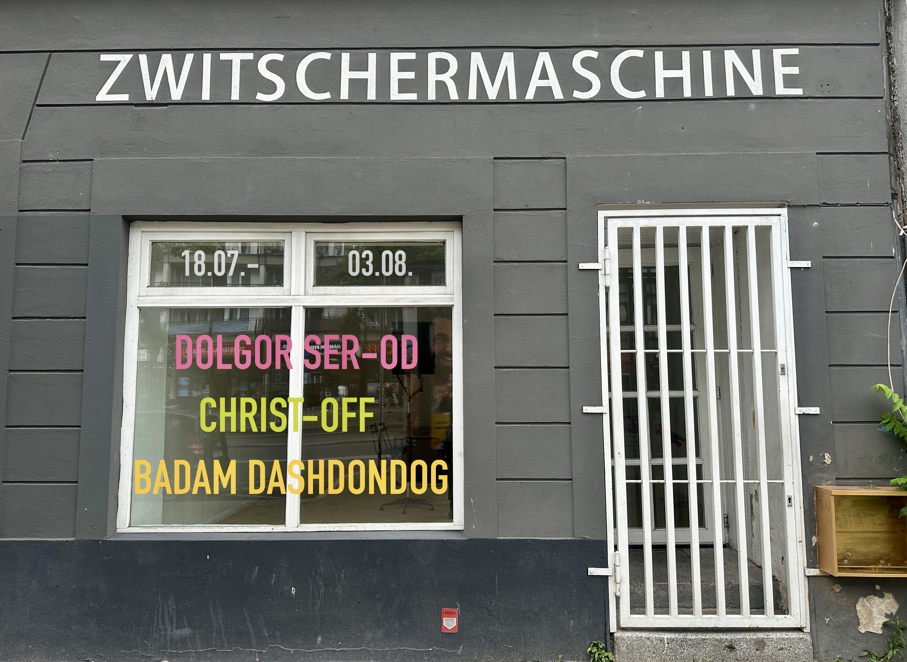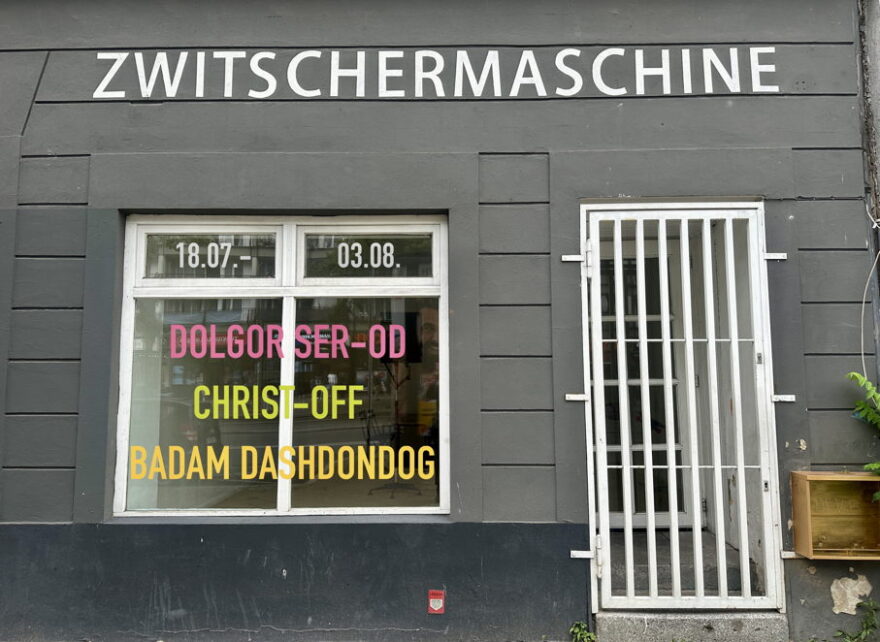Dolgor Ser-Od • Badam Dashdondog • Christ-Off
Malerei • Zeichnung • Skulptur

18.07.
Eröffnung: Fr 18.07.2025 • 19 Uhr
Ausstellung: 19.07. – 02.08. • Do – Sa 15 -18 Uhr (u.n.V.)
english below
Dolgor Ser-Od (Сэр-одын Долгор) wurde 1973 in Ulaanbaatar, Mongolei geboren.
Sie studierte traditionelle Malerei an der Akademie der Bildenden Künste in Ulaanbaatar. Neben traditionellen Malereien und Zeichnungen entstanden auch eine Reihe moderner Gemälde in Öl und Acryl. Ihre Arbeit zeichnet eine hohe Detailtreue aus. Darüberhinaus entwickelte Dolgor räumliche Interventionen für verschiedene Land-Art-Veranstaltungsorte und sie ist Mitbegründerin von Land Art Mongolia und Mitglied der Union of Mongolian Artists (UMA). 2008 siedelte sie nach Berlin über.
Sie hat international in Korea, China, Japan, Aserbaidschan, Frankreich oder Deutschland in privaten Galerien oder Museen wie dem Pori Art Museum in Finnland ausgestellt. Ihre Arbeit wurde 2001 als „bestes Gemälde des Jahres“ ausgezeichnet und ist in Kunstsammlungen wie der Khan Bank Collection, dem Badamhind Museum oder dem Parlamentsgebäude in Ulaanbaatar vertreten. Außerdem wurde sie in Printmedien wie World Sculpture News und L’Officiel D’Art rezensiert.
Badam Dashdondog ist eine der führenden zeitgenössischen Künstlerinnen der Mongolei, die sowohl in zeitgenössischen als auch in traditionellen mongolischen Malstilen arbeitet. Ihre Kunstwerke beschäftigen sich vorwiegend mit Themen, die in der traditionellen nomadischen Lebensweise der Mongolei verwurzelt sind. In den weitläufigen, expansiven Räumen, die sie darstellt, können Betrachter sowohl Spuren der Vergangenheit als auch der Gegenwart erkennen. Eine tiefere Auseinandersetzung mit ihrem Werk offenbart eine künstlerische Erzählung über die ewige Verbundenheit dieser Elemente. Ihre Bildsprache schafft gekonnt eine Balance zwischen östlichen und westlichen visuellen Ausdrucksformen, wobei sie sich nicht auf eine einzelne Person konzentriert, sondern universell spricht – eine Eigenschaft, die in Werken wie „Die vier Jahreszeiten“, „Nacht mit Vollmond“ und „Die weiße Stupa“ deutlich zum Ausdruck kommt.
Badam Dashdondogs kreative Praxis beschränkt sich nicht auf zweidimensionale Kunstformen. Seit 2017 arbeitet sie in den Bereichen Performance- und Installationskunst. Ihre zeitgenössischen Kunstprojekte untersuchen die Beziehung zwischen dem Greifbaren und dem Ungreifbaren und beziehen oft öffentliche Interaktionen und Aktionen in die Arbeit selbst mit ein. In ihrer Performance „NYMPHEAN TRIP 3“ aus dem Jahr 2022 – entstanden während der Zuun Art International Art Residency (https://www.youtube.com/watch?v=Hg7lO5iCOKs) – stellt sie die Verbindung zwischen Mensch und Natur symbolisch durch die Figur einer Schlange dar. In einer weiteren Performance, „Intersection“, die während des Bluesun Art Camp 2021 (https://www.youtube.com/watch?v=6zE_U0sthrM&t=26s) entstand, untersucht sie die endlosen und ursprungslosen Beziehungen zwischen Menschen.
Badam Dashdondog hat ihre Werke nicht nur in der Mongolei, sondern auch international ausgestellt, unter anderem in Frankreich, Dänemark, Deutschland, Südkorea, China, Russland und Italien.
Text von Enkhzaya
Die Götter, Geister und Konsorten, die dieses Heft bevölkern, wurden in Betten aus Sand geboren. Christ-off hat sie ihnen bereitet, hat sie aufgeschüttelt und die Formen der Figuren in den Sand gedrückt. Dann hat er sie gegossen aus dem paradigmatischen Werkstoff der Moderne: dem flüssigen Beton. So haben sie geruht bis zum Erwachen, denn erst vollkommene Erhärtung brachte sie ans Leben! Honi soit qui mal y pense.
Nun stehen sie vor uns: mit ihren schrundigen Leibern, freundlich ratlosen, manchmal auch scheinbar bösen Gesichtern, mit den verwegenen Gesten von hilflos wirkender Ausdruckskraft und zuweilen umgeben von floralen Aureolen. Oft als Zwitterwesen aus Mensch und Tier. Immer jedoch treten sie auf wie kreatürlich-pantomimische Figurinen, erscheinen als Allegorien gegenwärtig unbestimmter Existenz. Man könnte sie aber auch ganz gegenteilig als humoristische Karikaturen eben dieser Existenz betrachten, Götter und Geister als fröhliche Spieler im Gewebe von Götzentum und Gegenwart.
Als der Rabbi Löw weiland seinem aus den vier Elementen Erde, Wasser, Feuer und Luft geformten Golem ein stummes Leben einhauchte, war dessen Bestimmung, das Volk Gottes zu befreien. Christ-off aber, das sagt schon der (Künstler-)Name, ist Agnostiker und damit unverdächtig eschatologischer Motive. Und doch: Der Namenspatron aller derer, die Christoph heißen, ist der biblische Christophorus. Alseiner der 14 Nothelfer trug er das Jesuskind mit Hilfe eines kräftigen Stabes über den reißenden Fluss und gilt seit Jahrhunderten als der Beschützer der Reisenden und ihrer Fahrzeugführer.
Das ist insofern bedeutend, als ich den konkreten Christoph, meinen Freund Christ-off, auf etlichen gemeinsamen Reisen in entfernte Länder seit Jahren als einen solchen Beschützer kennengelernt habe.
Vielleicht ist es ja so, dass gerade Agnostiker nach Wegen wie Formen suchen, transzendentale Defizite aufzufüllen. Aber das wollen wir hier nicht vertiefen. Da sind ja noch die Mitläufer, Konsorten, die sich als Helfer zum Guten verdingen können, wie als Gesellen ungesühnter Verbrechen.
In dieser hermeneutischen Lücke zwischen Empathie und Abweisung, Schutz und Bedrohung operieren Christ-off und sein Kollektiv der aus den Betten Auferstandenen. Man sieht die Lust an der Entstehung der Gestalten und genießt die Mehrdeutigkeit, wenn man sich auf ihre Wesenheiten einlässt. Denn Ambiguität ist noch immer der Kern aller Kunst. Auch wenn das gerade etwas aus der Mode ist.
Möge dieses freudige Bestiarium die Wege finden, um seine Botschaft in die Welt hinauszutragen!
Matthias Flügge (Vorwort zu dem Katalog: Goetter, Geister & Konsorten)

Badam Dashdondog
Dolgor Ser-Od (Сэр-одын Долгор) was born in Ulaanbaatar, Mongolia, in 1973.
She studied traditional painting at the Academy of Fine Arts in Ulaanbaatar. In addition to traditional paintings and drawings, she also created a series of modern paintings in oil and acrylic. Her work is characterised by a high level of detail. Furthermore, Dolgor developed spatial interventions for various land art venues and is a co-founder of Land Art Mongolia and a member of the Union of Mongolian Artists (UMA). In 2008, she moved to Berlin.
She has exhibited internationally in Korea, China, Japan, Azerbaijan, France and Germany in private galleries and museums such as the Pori Art Museum in Finland. Her work was awarded ‘Best Painting of the Year’ in 2001 and is represented in art collections such as the Khan Bank Collection, the Badamhind Museum and the Parliament Building in Ulaanbaatar. She has also been reviewed in print media such as World Sculpture News and L’Officiel D’Art.
Badam Dashdondog is one of Mongolia’s leading contemporary artists, creating works in both contemporary and traditional Mongolian painting styles. Her artworks predominantly explore themes rooted in Mongolia’s traditional nomadic lifestyle. Within the vast, expansive spaces she depicts, viewers can trace both the marks of the past and the present. A deeper engagement with his work reveals an artistic narrative of the eternal interconnectedness of these elements. Her imagery skillfully balances Eastern and Western visual languages, not focusing on a single individual but speaking universally — a quality evident in works such as „The Four Seasons,“ „Night with a Full Moon,“ and „The White Stupa.“
Badam Dashdondog’s creative practice is not confined to two-dimensional art forms. Since 2017, she has been working in the fields of performance and installation art. Her contemporary art projects explore the relationship between the tangible and the intangible, often incorporating public interactions and actions into the work itself. In her 2022 performance piece „NYMPHEAN TRIP 3“ — created during the Zuun Art International Art Residency (https://www.youtube.com/watch?v=Hg7lO5iCOKs — she symbolically portrays the connection between humans and nature through the figure of a snake. In another performance, „Intersection,“ created during the 2021 Bluesun Art Camp (https://www.youtube.com/watch?v=6zE_U0sthrM&t=26s, she explores the endless and originless relationships between people.
Badam Dashdondog has exhibited her works not only in Mongolia but also internationally, including in France, Denmark, Germany, South Korea, China, Russia, and Italy.
Text by Enkhzaya
The Goetter, Geister & Konsorten (Gods, Spirits & Associates) that populate this booklet were born in beds of sand.
Christ-off prepared them, shook them up and pressed the shapes of the figures into the sand. Then he cast them from the paradigmatic material of modernism: liquid concrete. They rested like this until they awoke, because only when they had completely hardened did they come to life! Honi soit qui mal y pense.
Now they stand before us: with their chapped bodies, friendly helpless, sometimes seemingly evil faces, with bold gestures of seemingly helpless expressiveness and sometimes surrounded by floral aureoles. Often as hermaphrodites of human and animal. However, they always appear like creaturely pantomime figurines, appearing as allegories of a presently indeterminate existence. However, they could also be seen quite the opposite, as humorous caricatures of this very existence, gods and spirits as merry players in the web of idolatry and the present.
When Rabbi Löw breathed mute life into his golem, formed from the four elements of earth, water, fire and air, its purpose was to liberate the people of God. But Christ-off, as the (artist’s) name suggests, is an agnostic and thus unsuspiciously eschatological. And yet: the patron saint of all those called Christoph is the biblical Christophorus. As one of the 14 emergency helpers, he carried the baby Jesus across the raging river with the help of a sturdy staff and has been considered the protector of travelers and their drivers for centuries.
This is significant insofar as I have gotten to know the specific Christoph, my friend Christ-off, as such a protector on several trips together to distant countries over the years.
Perhaps it is the case that agnostics in particular are looking for ways and forms to fill transcendental deficits. But we don’t want to go into that here. There are also the followers, the consorts, who can serve as helpers for the good, as well as companions of unpunished crimes.
Christ-off and his collective of those who have risen from their beds operate in this hermeneutic gap between empathy and rejection, protection and threat. You can see the pleasure in the emergence of the figures and enjoy the ambiguity when you engage with their essence. Because ambiguity is still the core of all art. Even if it is somewhat out of fashion at the moment.
May this joyful bestiary find ways to carry its message out into the world!
Matthias Flügge (Foreword to the catalogue: Goetter, Geister & Konsorten)
